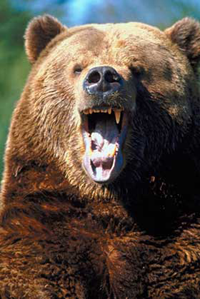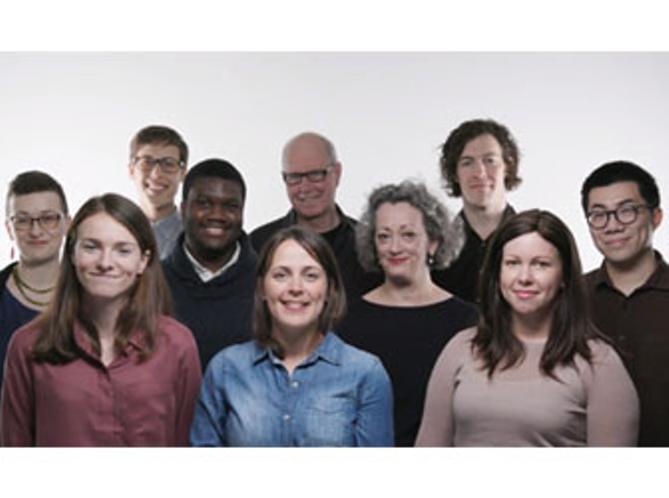
- The Black Grizzly of Whiskey Creek
- McClelland & Stewart (2008)
The only grizzly I've seen was in Jasper, a huge blond coming north from the Athabasca River. It was beautiful and intimidating, but I was more alarmed for the bear than for myself. I was safe in a car on the Edmonton-Jasper highway. The bear was running alongside the highway, looking for a gap in the traffic. I hope it found one.
Since 1978 I've spent part of every summer in Jasper, learning something new every time. One thing I finally learned a few years ago is that Jasper isn't a wilderness. Nothing is.
Ever since humans arrived in the Americas, we've turned our environment into an artifact. Whether we burn the forests or protect them, hunt animals or leave them alone, we set the terms of existence for every living thing.
In our national parks, we pretend to preserve "wilderness" so visitors will glimpse something "unspoiled" and "natural." To make it easy for the visitors, we punch rail lines and highways through the Rockies. We build hotels and motels, fast-food joints and T-shirt shops. Most park visitors, I'm told, never go more than 100 metres from the road.
Wildlife grazing on golf courses
Our impact on park wildlife is predictably disastrous. Some animals become road kill. Others compete with us for space on the valley bottoms, like the elk grazing on the golf course at Jasper Park Lodge.
Bears, especially, wander into Jasper, Banff, and Lake Louise, looking for human food, and especially human garbage. Their need for our thrown-away grease and protein brings them into dangerous contact with us. I well recall the day in Jasper when my wife chased away a young black bear, while a family of nearby picnickers happily took photos -- unaware that their food had probably attracted the bear.
Bad as the situation is, it used to be even worse. In the 1970s, when Sid Marty was a park warden in Banff, black bears got into the village landfill. Parks Canada shut down the landfill, so the bears migrated into town, to the restaurants' garbage bins. Parks Canada tried to get the restaurants and hotels to clean up, but its own campsites were equally a mess.
Late in the summer of 1980, this lack of policy cost the lives of a human and two bears, and left three other persons seriously mauled. In his latest book, Marty describes what happened -- from the viewpoint of the park wardens, and from that of the bears.
How the world looks to a bear
It's an imaginative approach, and not a sentimentalized one. Marty knows a lot about bears in general, and about the two bears in particular that terrorized Banff. So we can see how the world must look (and smell) to a hungry bear.
The result is an instructive and suspenseful story, even though the outcome is certain. At the time of the bear attacks, Marty had left the park service to become a freelance writer, but he knew most of the wardens. When he volunteered to help hunt down the bear, they welcomed him back. And a quarter-century later, most of them were willing to share their memories with him for this book.
A strong theme of political cynicism runs through the narrative. Parks Canada didn't want to hurt the tourism business, so when a warden actually charged a restaurant manager with failing to bear-proof his garbage, the warden ended up with a reprimand.
The first attack -- on two men fishing -- occurred not long before the Labour Day long weekend, Banff's last chance of the year to make big tourism money. So the wardens were under pressure to get rid of the bear as fast as possible.
They faced confusion from the outset: The animal in the first attack seemed to be a very large black bear. But the first victim, before he died with his lower face torn off, wrote in hospital that it had to be a grizzly.
A case of mistaken identity?
When the black bear was tracked and shot, he turned out to be a local resident with his own tattoo. The threat seemed to be over. The wardens allowed visitors to go back into the Whiskey Creek area.
Then more attacks came, on two Swiss men and a young would-be car thief. The wardens still weren't sure it was a grizzly. But when they finally saw its tracks, they were shocked by how big it must be. For several days they and the grizzly hunted each other. Finally, a road-killed elk provided the bait for an ambush. Weighing 761 pounds (345 kg), the second-largest grizzly in Banff's records was dead.
According to Marty, we won't see his like again. Parks Canada finally cracked down on the garbage problem. Those bear-proof containers you see in parks and highway rest areas are the direct result of Whiskey Creek, and they have largely solved the garbage-bear problem.
Humans as agents of evolution
But we have been acting as agents of evolution. Marty points out that in the old days, garbage bears would be doped and carried far from town -- sometimes repeatedly. Wardens would shoot only the aggressive ones. The effect of this was to delete aggressive bears from the local gene pool. The Whiskey Creek grizzly, 10 years old, was an outsider, unknown to the wardens. The only bigger grizzly in Banff was Sparky, a peaceful old 800-pound (362 kg) garbage addict who'd lived around Lake Louise for years.
Now, however, the lack of high-calorie food is literally stunting the growth of Banff's grizzlies. To breed, they must be big and fat. It's taking them longer to reach sexual maturity. When they try to graze on berries (at the rate of 200,000 buffalo berries a day), humans too often interrupt their feeding. So the grizzlies are not reproducing very rapidly.
Grizzlies and black bears may scare us, but they are as much our artifacts as pit bulls and golden retrievers. We have shaped their environment and shaped their genes. But we have not yet assumed responsibility for them. Sid Marty's book takes us a step closer to that responsibility.




